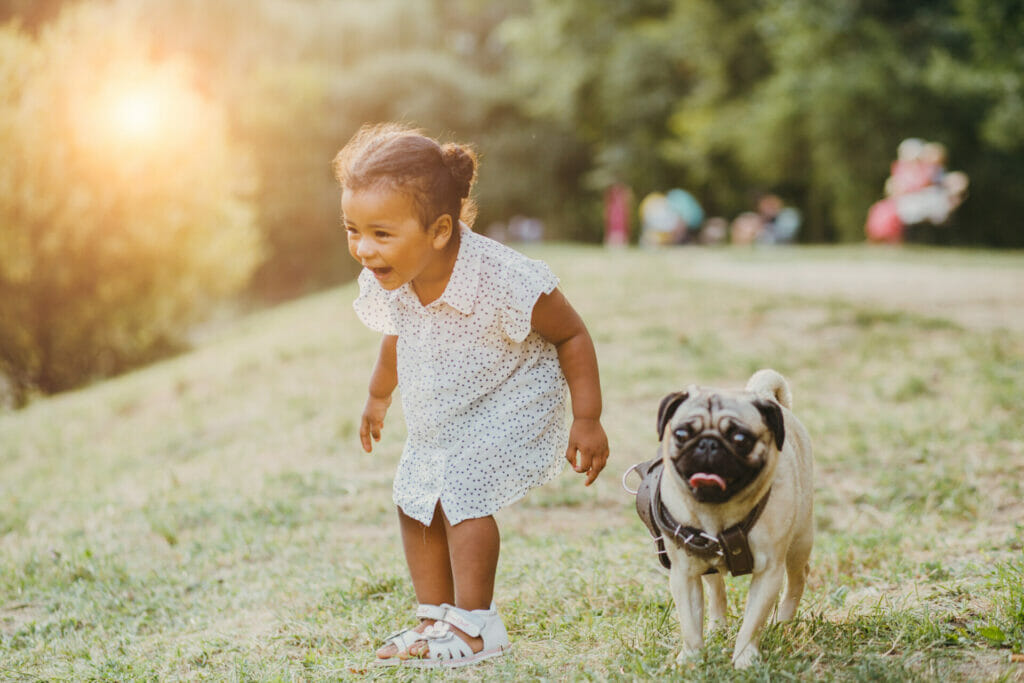Are you tired of your dog and toddler constantly fighting over toys and attention? Don’t worry; you’re not alone. But, with patience and many treats, you can turn that furry, four-legged rivalry into a friendship for the ages. In this article, we’ll show you how to encourage your dog and toddler to play together and become the best buds. So put down the chew toy and grab a laugh because it’s time to bring harmony to your household.
Six Ways to Develop a Friendly Bond Between Your Dog & Toddler
Here are six easy ways to improve bonding between your cute pet dog and toddler. No matter how much they are new to each other, these strategies will indeed work.
1. Socializing Your Little Pup
Do you know the right time in a dog’s life to learn and adapt things the best? It’s when they’re still puppies; otherwise, they’re too busy chasing their tail to pay attention!
Dogs learn most things between 3 to 4 months of their initial developing age. That is why you should do nice things, introduce new people, and train them accordingly from an early stage. Teach them all the good doggy manners while they’re still in their puppy phase, or you’ll be in for a lifetime of trouble (and chewed-up shoes).
2. Treat Your Dog
The best way to make someone feel excellent about their actions is to treat them, especially when it involves your little pet. We all know how much dogs love treats and how much they long for them.
That is, in fact, a great tactic you can use to praise your dog whenever they behave nicely with your toddler. Your pup will naturally feel more comfortable and happy around your toddler if you start rewarding it for its good behavior.
How about bringing loads of smiles and laughter to your house by sacrificing a few treats? This positive reinforcement ritual from your side can always prove beneficial in training your dog to act friendly with your toddlers.
3. Go For Park Outing
A simple stroll can completely change your puppy’s mood and bring waves of happiness, freedom, joy, and comfort to your dog, which you can never achieve indoors.
Imagine a simple scenario—a fantastic sunny day in a park with your pup and the toddler. You let your pup run around and just let it do cute dog stuff and chill around. At the same time, you sit around with your toddler taking in the sun. Now you know that your pup is in a good mood, your toddler sure is, and you, too, are savoring the moment. So why not let your puppy and toddler interact for a while?
To make their interaction more fun, you can drop a softball with which they can play for a bit. Now things can go sideways, but the chances are very low as the pent-up energy in your pup isn’t there, and it will be less likely to react to any sudden changes.
4. Give Your Dog Some Time to Adapt
You never get the results of anything within minutes, everything takes time, and this is the case when developing your dog’s bond with your toddler. One of the best strategies is to wait and naturally let everything happen instead of forcing this on your pup.
You are responsible for introducing your toddler to your pet dog and giving them both space with each other. Also, give some time to get comfortable with each other and to know and understand each other better.
The important thing is to make your dog understand your toddler’s scents, toys, or bottles; for this, you surely need to give your pup some time.
5. Proper Supervision
To establish a healthy relationship between your toddler and dog is to supervise them properly. Start training them both gradually, and let them have sufficient time together to let them understand each other.
Proper supervision when your pets are around your toddlers must be an essential responsibility for every pet owner.
When your pets are familiar with you, they won’t harm you. But still, when irritated, they can scratch your toddler’s face or bite his little leg. That may not be intentional every time, but it can happen due to something your dog didn’t like from your toddler’s side.
You might have heard about the numerous stories of pets harming little kids, so keep a proper eye to prevent these stories from arising from your home.
6. Understand Dog’s Language
Understanding your dog’s body language is crucial in solving half the problems you face in your daily life involving your pup. Your little friend tells you everything by wagging its tail, nodding its head, and through those cute little barks.
For example, when wagging its tail, your dog doesn’t necessarily represent happiness; it can also indicate your dog’s stress, excitement, and aggression.
You can learn this stuff with experience, but getting professional help can put you ahead in solving the problems and ensuring a better environment around your household.
To Wrap It Up
In conclusion, encouraging your dog and toddler to play together can be a fun and rewarding experience for both the child and the pet. You can help your furry friend and your little one develop a strong bond by setting clear boundaries, using positive reinforcement, and supervising their interactions. Remember always to keep safety in mind and to have patience, as it may take some time for your dog and toddler to understand and trust each other fully. With a little effort and much love, your dog and toddler can be best friends in no time!




















